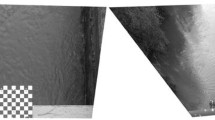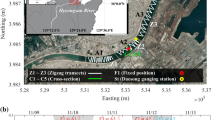Abstract
To experimentally study transient flows such as dam-break flows, imaging techniques are often used due to the constraints imposed by the highly transient nature of such phenomena. In this paper an experimental laboratory study of tailings dams made with a combined PIV + PTV algorithm is presented. In this algorithm the PIV technique is first applied to determine an estimator for the sediment layer velocity field. The obtained estimator is then used to compute a displacement estimator for the PTV approach. In this method the first step (PIV) provides a global estimation of the sediments velocity field and in the second step (PTV) a particle-by-particle analysis is obtained leading to an increased spatial resolution of the measurements. The obtained algorithm is applied to a laboratory tailings dam-break flow to obtain relevant information about the behavior of the tailings. This paper is a summary of the research presented in other papers by the authors.
Access this chapter
Tax calculation will be finalised at checkout
Purchases are for personal use only
Similar content being viewed by others
References
Aleixo R, Soares-Frazão S, Zech Y (2011) Velocity-field measurements in a dam-break flow using a PTV Voronoï imaging technique. Exp Fluids 50(6):1633
Aleixo R, Ozeren Y, Altinakar M, Wren D (2014a) Velocity field measurements in tailings dam failure experiments using a combined PIV-PTV approach. In: Proceedings of the 3rd IAHR Europe conference. Porto, Portugal
Aleixo R, Ozeren Y, Altinakar M (2014b) Tailings dam-break flow analysis by means of a combined PIV-PTV tool. In: Proceedings of the river flow 2014 conference, Lausanne, Switzerland
Capart H, Young D, Zech Y (2002) Voronoï imaging methods for the measurement of granular flows. Exp Fluids 32:121
Cowen E, Monismith S (1997) An hybrid digital particle tracking velocimetry technique. Exp Fluids 22:199
Keane R, Adrian R (1992) Theory of cross-correlation analysis of PIV images. Appl Sci Res 49:191
Lueptowand RM, Akonu A, Shinbrot T (2000) PIV for granular flows. Exp Fluids 28(2):183
Oertel M, Bung D (2012) Initial stage of two-dimensional dam-break waves: laboratory versus VOF. J Hydraul Res 50(1):89
Ozeren Y, Altinakar M, Wren D (2013) Experimental measurements of dam-break flow. In: 6th international perspective on water resources and the environment conference (IPWE 2013), Izmir, Turkey, 7–9 Jan 2013
Pudasani S, Hsiau SS, Wang Y, Hutter K (2005) Velocity measurements in dry granular avalanches using particle image velocimetry technique and comparison with theoretical predictions. Phys Fluids 17(9):093301
Raffel M, Willert C, Werely S, Kompenhans J (2007) Particle image velocimetry—a practical guide. Springer, Heidelberg
Rico M, Benito G, Salgueiro A, Diez-Herrero A, Pereira H (2007) Reported tailings dam failures: a review of the european incidents in the worldwide context. Elsevier, Netherlands
Scarano F, Riethmuller M (2000) Advances in iterative multigrid PIV image processing. Exp Fluids 29:S051–S060
Spinewine B, Capart H, Larcher M, Zech Y (2003) Three-dimensional Voronoï imaging methods for the measurement of near-wall particulate flows. Exp Fluids 34(2):227
Stitou A, Riethmuller M (2001) Extension of PIV to super resolution using PTV. Meas Sci Technol 12:1398
Sveen K (2004) An introduction to MatPIV v. 1.6.1, no 2 ISSN 2:0809–4403
Acknowledgments
This work was supported by the US Department of Homeland Security sponsored Southeast Region Research Initiative (SERRI) at the US Department of Energy Oak Ridge National Laboratory, and to the USDA Agriculture Research Service under the Specific Research Agreement No. 58-6408-1-609 monitored by the USDA-ARS National Sedimentation Laboratory (NSL) and The University of Mississippi (UM). The authors also thank the technical support provided by J. Ferguson, A. Gebrehana and T. Gannaway during the experimental campaign.
First author is now supported by the Research Executive Agency, through the 7th Framework Programme of the European Union, Support for Training and Career Development of Researchers (Marie Curie FP7PEOPLE2012ITN), which funded the Initial Training Network (ITN) HYTECH: Hydrodynamic Transport in Ecologically Critical Heterogeneous Interfaces, No. 316546.
Author information
Authors and Affiliations
Corresponding author
Editor information
Editors and Affiliations
Rights and permissions
Copyright information
© 2016 Springer International Publishing Switzerland
About this chapter
Cite this chapter
Aleixo, R., Ozeren, Y., Altinakar, M. (2016). PIV-PTV Measurements of a Tailings Dam-Break Flow. In: Rowiński, P., Marion, A. (eds) Hydrodynamic and Mass Transport at Freshwater Aquatic Interfaces. GeoPlanet: Earth and Planetary Sciences. Springer, Cham. https://doi.org/10.1007/978-3-319-27750-9_21
Download citation
DOI: https://doi.org/10.1007/978-3-319-27750-9_21
Published:
Publisher Name: Springer, Cham
Print ISBN: 978-3-319-27749-3
Online ISBN: 978-3-319-27750-9
eBook Packages: Earth and Environmental ScienceEarth and Environmental Science (R0)




